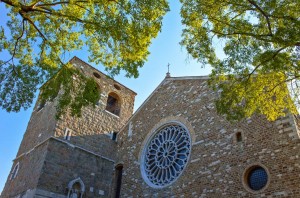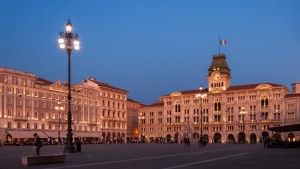
©Bigstock.com/Gimas
There’s no doubt that Trieste has a special status. The city in north-eastern Italy, only a few kilometres from the Slovenian border, can look back on an eventful history that left its mark on every corner of the capital of the autonomous region Friuli-Venezia Giulia. Having been an important port for Austria and later the Austria-Hungarian Empire before “losing” its hinterland, Trieste even used to be almost isolated on the east-west border. The city of arts now is an important free port and popular holiday destination that even managed to increase its significance over the years thanks to amazing beaches and enthralling sights. Which sights, you ask? Well, that’s what we’re here for.
A pawn of great rulers
The region around Trieste has always been very important. Analysing the entire history of the coastal city would go beyond the scope of what we’re doing here, so let’s just focus on the key points. The region used to be the home of Celtic and Illyrian tribes. When the Romans started to conquer Istria from 177 BC onward, they established several military camps. The Tergeste colony would follow around 50 years later. From then on, the area predominantly served as an exclusive tourist resort and, for some time, even as a border fortress. Hit hard by the Migration Period, the Bishops of Trieste would eventually rule for several centuries until the conquest by Venice lead to conflicts that lasted 180 years. The voluntary submission in 1382 put Trieste into Habsburg-Austrian hands until the end of the First World War.
Despite heavy initial resistance, Trieste managed to stabilise during the Habsburg rule. Achieving free port status in 1719 plus the Austrian conquest of Venice gave the city a leading position in international trade. This wealth resulted in remarkable architectural achievements during the Wilhelminian time eventually clashing with growing industrialisation and burgeoning nationalism. Fully hijacked by fascist powers after the First World War, the Paris Peace Treaty of 1947 defined most of the region as the Free Territory of Trieste. The neutral state was later dissolved. Trieste and its close surroundings went to Italy, the hinterland and north-western Istria to Yugoslavia. It took until 1975 for this demarcation to be officially confirmed. Trieste only lost its marginal geographic and economic position in the early 2000s when Slovenia joined the EU and the Schengen area.
Piazza dell’Unità d’Italia and Piazza Verdi

©Bigstock.com/NPershaj
Trieste leaves us – and you – spoilt for choice. There are so many thrilling places and almost magical sights waiting for curious minds, one does wonder where to start. Well, why don’t you join us on a tour of Trieste from square to square, district to district, to cherry-pick genuine gems? We start in central Trieste on Piazza dell’Unità d’Italia. Being the largest square in the entire city, it is also known as Piazza Grande. Several neoclassical and baroque buildings frame the Piazza on three sides, such as:
- The city hall Palazzo del Municipio was inspired by the Louvre and the Scuola Grande di San Rocco in Venice. Two bronze statues strike the tower clock at the top of every hour.
- Palazzo Pitteri dates back to 1790. The oldest building on the square carries the name of the writer Riccardo Pitteri and currently belongs to an insurance company.
- Heinrich von Ferstel, architect of the Votive Church in Vienna, designed the Palazzo del Lloyd Trestino. Ferstel was inspired by Italian Renaissance architecture when creating the palace of the Austrian shipping company.
- Originally intended as an inn, Palazzo Modello perfectly embodies Trieste’s eclectic historicism. Ancient elements, Italian Renaissance, medieval styles, and baroque ideas come together here.
Piazza Verdi directly adjoins Trieste’s centrepiece. It is the site of Teatro Verdi, named after the world-famous composer Giuseppe Verdi. Several of Verdi’s operas premiered here. The old stock exchange rises in the background. The front with its portico looks like a Doric temple.
Borgo Teresiano and Borgo Giuseppino
Two of Trieste’s larger districts stretch from Piazza dell’Unità d’Italia to somewhat more remote parts of the city. Borgo Teresiano, for example, extends as far as the central station. The area was built on drained saltworks per decree of Empress Maria Theresa. The stunning Canal Grande, fully lighted at night, runs through the entire district as its principal axis. It ends at the neoclassical church Sant’Antonio Nuovo, Trieste’s largest Catholic church. Awe-inspiring works of Venetian and German painters adorn the interior. Many other churches, such as the Greek Orthodox San Nicolò dei Greci, the Serbian Orthodox San Spiridione and Trieste’s synagogue, are also located in this district.
Borgo Giuseppino, however, extends as far as Campo Marzio, the seafront and Piazza Attilio Horti. Piazza Venezia, which is open toward the sea, with Molo Veneziano and Molo Sartorio is the heart of and soul of this district. Among the Borgo’s major sights are the Renaissance-style Museo Revoltella and the city library Biblioteca Civica Attilio Hortis.
Historic centre and Colle di San Giusto
Piazza dell’Unità d’Italia extends as far as the hill of San Giusto with the oldest part of Trieste, the historic centre, at its foot. Mussolini had it destroyed and degenerated to unearth ancient remains. Those include the ruins of the Roman theatre Teatro Romano likely built in the 1st century AD. Romanesque San Silvestro from the 11th century is probably the oldest church in the entire city and pretty much towered over by the baroque Santa Maria Maggiore. You absolutely must look at the cupola from the inside! Arco di Riccardo, the last surviving part of the Roman city walls from Augustine times, rises behind the two churches.
Trieste Cathedral, Trieste’s most significant building, is situated on the hill of San Giusto itself. This 14th century Romanesque cathedral incorporates elements of its predecessors from Roman and Christian times. There’s so much here for you to discover from the asymmetric façade with a Gothic rose window to the towering Campanile with its Romanesque frieze in the stairway to the astonishing altars inside the chapels and the cathedral itself. Castel San Giusto is quite astounding as well. Despite its massive look it hardly ever carried any military significance. Talking about hills, we would be remiss not to mention Temple of Monte Grisa a few kilometres outside of Trieste. The odd, triangular shape of this Brutalism style building from the 1960s will immediately catch your eye.
We’ve at least scratched Trieste’s surface. The fascinating history, wide port and numerous squares have so much more magical treasures to offer. In short, you absolutely must visit Trieste and see it with your own eyes! You certainly won’t be disappointed.